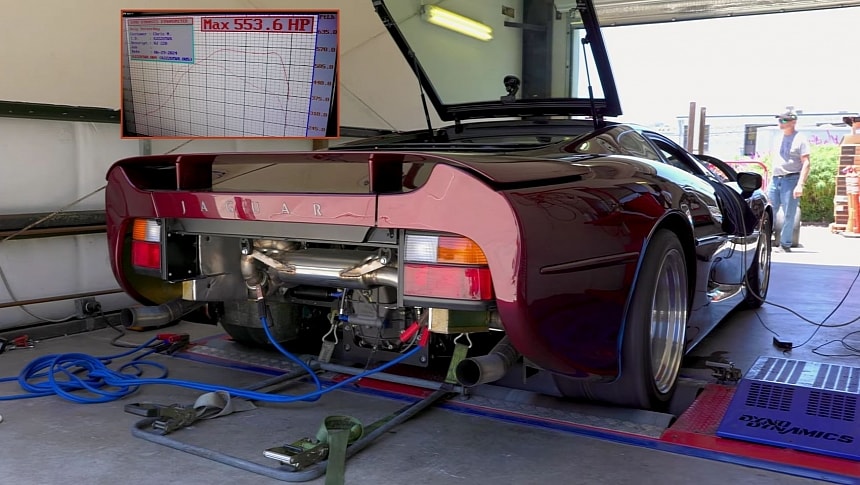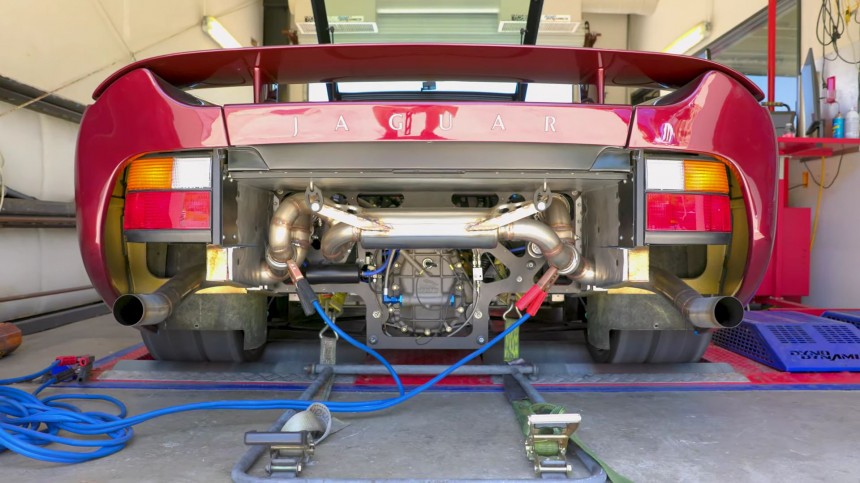A flawed machine that nevertheless captured the imagination of many enthusiasts, the XJ220 was intended to feature all-wheel drive and V12 muscle. However, the folks at Jaguar and TWR were forced to downgrade to rear-wheel drive and six cylinders augmented by two snails.
The rally-bred engine was advertised by the British automaker with 542 horsepower and 475 pound-feet (644 Nm) to its name, which – for 1992 – was a helluva lot for 3.5 liters and six pots. For a brief period, the V6-engined XJ220 was the world's fastest production car, having clocked 217.1 miles per hour (349.4 kilometers per hour) at the Nardo Technical Center in Italy.
The Jaguar and TWR joint venture JaguarSport stopped making the XJ220 in 1994 after the 282th example rolled off the assembly line in Bloxham. Chassis number 203 was recently upgraded by San Diego-based Otsuka Maxwell Design, which started the project by replacing the original fuel cell.
OMD further worked its magic on the suspension, brakes, exhaust, wiring, fueling system, and turbos, which may upset quite a few purists. The car had less than 1,000 original kilometers on the clock when Otsuka Maxwell Design was tasked with bringing it back on the road, with the client also ponying up top dollar for a number of very tasteful improvements.
Take, for instance, the custom wheels, with the fronts measuring 18 inches compared to the original 17 inches. The rubber had also been upgraded to Toyo R888R tires measuring 265/35 by 18 and 345/30 by 19 inches, respectively.
The three-decade-old supercar also had its braking system replaced with high-performance AP Racing six-piston directional forged brakes with custom rotor hats. Compared to the original 330- and 300-millimeter brake rotors, it now features 362-millimeter units at every corner.
Before prepping the XJ220 for delivery to the customer, the company had to fine-tune the engine on the dynamometer to ensure that it's perfectly so for daily driving. It originally ran too rich, laying down a very respectable 528.6 horsepower at the rear wheels compared to Jaguar's crankshaft rating of 542 horsepower.
The first pull at full power ended with the dyno indicating 551.1 wheel horsepower, and the final run ended with 553.6 ponies. Assuming a 15-percent driveline loss, chassis number 203 makes over 630 horsepower at the crank.
Everything that was modified is reversible, meaning that the next owner will be capable of reverting back to the original specification if they so desire. The question is, would anyone do that after Otsuka Maxwell Design put so much effort into improving the recipe without altering the character of Jaguar's final mid-engine road car?
Prior to the XJ220, the XJR-15 was built from 1990 through 1992 in a little over 50 units. Compared to its force-fed successor, the TWR-developed model is more of a racing car for the road. It also differs from the XJ220 by means of a 6.0-liter V12 of the naturally aspirated variety, which develops in the ballpark of 450 horses.
The Jaguar and TWR joint venture JaguarSport stopped making the XJ220 in 1994 after the 282th example rolled off the assembly line in Bloxham. Chassis number 203 was recently upgraded by San Diego-based Otsuka Maxwell Design, which started the project by replacing the original fuel cell.
OMD further worked its magic on the suspension, brakes, exhaust, wiring, fueling system, and turbos, which may upset quite a few purists. The car had less than 1,000 original kilometers on the clock when Otsuka Maxwell Design was tasked with bringing it back on the road, with the client also ponying up top dollar for a number of very tasteful improvements.
Take, for instance, the custom wheels, with the fronts measuring 18 inches compared to the original 17 inches. The rubber had also been upgraded to Toyo R888R tires measuring 265/35 by 18 and 345/30 by 19 inches, respectively.
Before prepping the XJ220 for delivery to the customer, the company had to fine-tune the engine on the dynamometer to ensure that it's perfectly so for daily driving. It originally ran too rich, laying down a very respectable 528.6 horsepower at the rear wheels compared to Jaguar's crankshaft rating of 542 horsepower.
The first pull at full power ended with the dyno indicating 551.1 wheel horsepower, and the final run ended with 553.6 ponies. Assuming a 15-percent driveline loss, chassis number 203 makes over 630 horsepower at the crank.
Everything that was modified is reversible, meaning that the next owner will be capable of reverting back to the original specification if they so desire. The question is, would anyone do that after Otsuka Maxwell Design put so much effort into improving the recipe without altering the character of Jaguar's final mid-engine road car?
Prior to the XJ220, the XJR-15 was built from 1990 through 1992 in a little over 50 units. Compared to its force-fed successor, the TWR-developed model is more of a racing car for the road. It also differs from the XJ220 by means of a 6.0-liter V12 of the naturally aspirated variety, which develops in the ballpark of 450 horses.



























